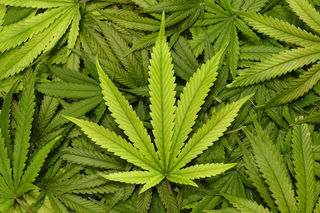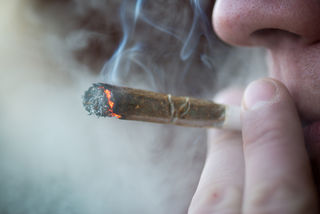Alcoholism
Cannabis Use Disorders Are Skyrocketing in the United States
6 million Americans have marijuana use disorders; few addicts receive treatment.
Posted March 21, 2016

A new study reports that cannabis use disorders (CUD) in the United States are rising dramatically. According to this study, the percentage of Americans who reported using marijuana in the past year doubled between 2002 and 2012.
Unfortunately, only 13.2% of people with lifetime cannabis use disorder participated in 12-step programs or sought professional treatment for their addiction.
Cannabis is defined as any of the various parts of the hemp plant, cannabis sativa, from which marijuana, hashish, and similar mildly euphorigenic and hallucinogenic drugs are prepared. The terms "cannabis" and "marijuana" are often used interchangeably.
The latest research shows that approximately 2.5 percent of American adults—nearly 6 million people—experienced marijuana use disorder in the past year. Of those who used marijuana, 6.3 percent met the latest DSM-5 diagnostic criteria for CUD at some point in their lives.
The study also found that marijuana use disorder—which is often associated with other substance use disorders, behavioral problems, and disability—goes largely untreated for the majority of Americans.
Marijuana Use Disorders Have Doubled in the Past Decade
The March 2016 study, “Prevalence and Correlates of DSM-5 Cannabis Use Disorder, 2012-2013: Findings from the National Epidemiologic Survey on Alcohol and Related Conditions–III,” was published in the American Journal of Psychiatry.
This study was a collaboration between researchers at Columbia University's Mailman School of Public Health, Columbia University Medical Center, and the National Institute on Alcohol Abuse and Alcoholism (NIAAA), part of the National Institutes of Health (NIH).
The researchers interviewed over 36,000 U.S. adults about their alcohol, drug, and related psychiatric conditions. This was the largest study ever to examine the co-occurrence of alcohol use, drug use, and related psychiatric conditions.
Cannabis use disorder was associated with other substance use disorders, affective disorders, anxiety, and personality disorders. For example, one of the findings of this study was that adults who use cannabis are five times more likely to develop an alcohol use disorder (AUD)—compared with adults who do not use marijuana.
The researchers found that only about 7 percent of people with past-year marijuana use disorder received any marijuana-specific treatment, and only about 13 percent of people with lifetime marijuana use disorder receive treatment.
In a November 2015 Psychology Today blog post, “Why Have Marijuana Use Disorders Doubled in the Past Decade?” I reported on the findings of an earlier study by this team, which showed that men are twice as likely than women to have a cannabis use disorder. Also, younger age groups are much more likely to experience the disorder than people age 45 and over. People with the lowest income levels were at the highest risk.
How Does the DSM-5 Categorize Cannabis Use Disorder (CUD)?
The latest study is the first national survey to use the current diagnostic criteria from Diagnostic and Statistical Manual of Mental Disorders (DSM-5). In DSM-5, the two separate categories of “marijuana dependence” and “marijuana abuse” have been combined into a single disorder.
To be diagnosed with CUD, individuals must meet at least two of 11 symptoms that assess craving, withdrawal, lack of control, and negative effects on personal and professional responsibilities. The severity of CUD is rated as mild, moderate, or severe depending on the number of symptoms someone displays.
When soliciting information related to acute or chronic marijuana use, clinicians are advised to keep in mind the diagnostic criteria below. According to the DSM-5, a problematic pattern of cannabis use leading to clinically significant impairment or distress, is manifested by at least 2 of the following 11 symptoms, occurring within a 12-month period:
- Cannabis is often taken in larger amounts or over a longer period than was intended.
- There is a persistent desire or unsuccessful efforts to cut down or control cannabis use.
- A great deal of time is spent in activities necessary to obtain cannabis, use cannabis, or recover from its effects.
- Craving, or a strong desire or urge to use cannabis.
- Recurrent cannabis use resulting in a failure to fulfill major role obligations at work, school, or home.
- Continued cannabis use despite having persistent or recurrent social or interpersonal problems caused or exacerbated by the effects of cannabis.
- Important social, occupational, or recreational activities are given up or reduced because of cannabis use.
- Recurrent cannabis use in situations in which it is physically hazardous.
- Cannabis use is continued despite knowledge of having a persistent or recurrent physical or psychological problem that is likely to have been caused or exacerbated by cannabis.
- Tolerance, as defined by either a (1) need for markedly increased cannabis to achieve intoxication or desired effect or (2) markedly diminished effect with continued use of the same amount of the substance.
- Withdrawal, as manifested by either (1) the characteristic withdrawal syndrome for cannabis or (2) cannabis is taken to relieve or avoid withdrawal symptoms.
Deborah Hasin, Ph.D., lead author and professor of epidemiology in the Department of Psychiatry at CUMC, was a member of the group responsible for making these changes in DSM-5 substance use diagnostic criteria, including marijuana use disorders. In a study published last year, Dr. Hasin reported that three out of 10 marijuana users experienced marijuana abuse or dependence in 2012-13.

In a press release, Hasin said, "An increasing number of American adults do not perceive marijuana use as harmful. While some can use marijuana without harms, other users do experience negative consequences, which can include mental and physical problems, and impaired functioning. This paper helps provide information on some of those risks."
These findings corroborate research conducted last year at Stanford University Medical Center which found that adolescents commonly have a misconception that smoking cannabis is harmless. The researchers found that adolescents get a strong message that smoking traditional cigarettes is addictive and harmful. However, most teens are unclear about the health risks of vaping and smoking marijuana.
In fact, many teenagers presume that cannabis and e-cigarettes are actually a 'beneficial' habit based on misperceptions of their risks. The June 2015 study, “Adolescents' Perceptions of Risks and Benefits of Conventional Cigarettes, E-cigarettes, and Marijuana: A Qualitative Analysis,” was published in the Journal of Adolescent Health.
In a press release, the Stanford study's lead author, Maria Roditis, Ph.D., said, "Kids were really good at describing the harmful things that happen with cigarette smoking, but when we asked about other products, there was a lot of confusion.”
Bonnie Halpern-Felsher, Ph.D., professor of pediatrics in adolescent medicine and the study's senior author added, "We're good at delivering messaging that cigarettes are harmful, but we need to do a better job with other products that teens may smoke. We don't want the message kids get to be 'cigarettes are bad, so everything else might be OK.'"
Halpern-Felsher and Roditis found that students viewed getting high as a benefit to smoking marijuana, and perceived cannabis as being safer and less addictive than tobacco. The adolescents were unsure whether marijuana posed health risks, and commonly described being under peer pressure to smoke marijuana.
Available Treatments for Marijuana Use Disorders
According to the NIH’s National Institute of Drug Abuse, marijuana addiction appears to be very similar to other substance use disorders, although the long-term clinical outcomes of CUD may be less severe. On average, adults seeking treatment for marijuana use disorders have used marijuana nearly every day for more than 10 years and have attempted to quit more than six times.
The NIH points out that people with marijuana use disorders, especially adolescents, often suffer from other psychiatric disorders (comorbidity). A wide range of studies indicate that simultaneously treating mental health, along with standard treatments for substance abuse, may help reduce marijuana use, particularly among heavy users and those with chronic mental disorders.
According to the NIH, the following behavioral treatments have shown promise for treating cannabis use disorders:
- Cognitive-behavioral therapy: A form of psychotherapy that teaches people strategies to identify and correct problematic behaviors in order to enhance self-control, stop drug use, and address a range of other problems that often co-occur with them.
- Contingency management: A therapeutic management approach based on frequent monitoring of the target behavior and the provision (or removal) of tangible, positive rewards when the target behavior occurs (or does not).
- Motivational enhancement therapy: A systematic form of intervention designed to produce rapid, internally motivated change; the therapy does not attempt to treat the person, but rather mobilize their own internal resources for change and engagement in treatment.
Currently, no medications are used for the treatment of marijuana use disorder, but there is ongoing research in this area. Typically, sleep problems occur during marijuana withdrawal. Therefore, researchers are examining the effectiveness of sleep aids as part of treating CUD.
Conclusion: Cannabis Abuse and Lack of Treatment Is a Public Health Crisis
The latest findings put the public health concerns of CUD, as well as the need to improve education and prevention of heavy marijuana use, in the spotlight. Hasin concludes, "We feel strongly that more public education about the dangers associated with marijuana use is imperative. This is especially critical since we are learning more about public beliefs that marijuana use is harmless.”
The authors of the latest study underscore the urgent need to identify and implement effective prevention and treatments for cannabis use disorder nationwide. They're also urging policymakers to call for more research on the combined effects of marijuana and alcohol abuse.
To read more on this topic, check out my Psychology Today blog posts,
- "Why Have Marijuana Use Disorders Doubled in the Past Decade?"
- "Heavy Marijuana Use Alters Teenage Brain Structure"
- "High Potency Marijuana Damages Cerebral Brain Connections"
- "Why Are Cannabis Users Susceptible to Memory Distortions?"
- "Consuming Legalized Marijuana Is Blindsiding Out-of-Towners"
© 2016 Christopher Bergland. All rights reserved.
Follow me on Twitter @ckbergland for updates on The Athlete’s Way blog posts.
The Athlete’s Way ® is a registered trademark of Christopher Bergland.




